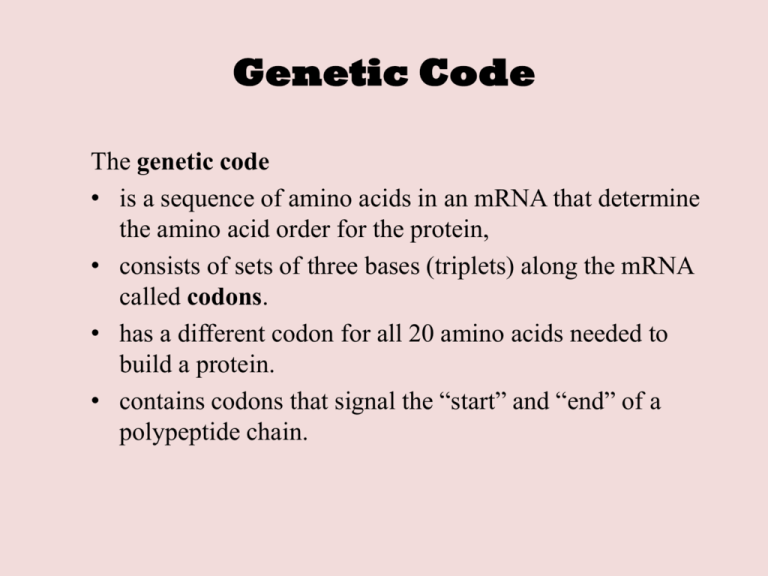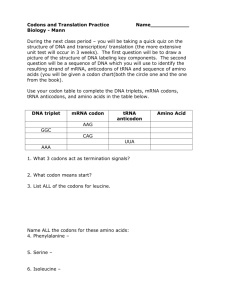Genetic Code
advertisement

Genetic Code The genetic code • is a sequence of amino acids in an mRNA that determine the amino acid order for the protein, • consists of sets of three bases (triplets) along the mRNA called codons. • has a different codon for all 20 amino acids needed to build a protein. • contains codons that signal the “start” and “end” of a polypeptide chain. The Genetic Code: mRNA Codons Codons and Amino Acids • Suppose we want to determine the amino acids coded for in the following section of a mRNA: 5′—CCU —AGC—GGA—CUU—3′ • According to the genetic code, the amino acids for these codons are: CCU = Proline AGC = Serine GGA = Glycine CUU = Leucine • The mRNA section codes for the amino acid sequence is as follows: Pro—Ser—Gly—Leu Learning Check Solution tRNA Activation The activation of tRNA • occurs when a synthetase uses energy from ATP hydrolysis to attach an amino acid to a specific tRNA. • prepares each tRNA to use a triplet called an anticodon to complement a codon on mRNA. Initiation and Chain Elongation For the initiation of protein synthesis, • an mRNA binds to a ribosome, • the start codon (AUG) binds to a tRNA with methionine, • the second codon attaches to a tRNA with the next amino acid, and • a peptide bond forms between the adjacent amino acids at the first and second codons. Translocation During translocation, • the first tRNA detaches from the ribosome, • the ribosome shifts to the adjacent codon on the mRNA, • a new tRNA/amino acid attaches to the open binding site, • a peptide bond forms, and the empty tRNA detaches, and • the ribosome moves down the mRNA to read the next codon. Protein Synthesis Chain Termination The termination of protein synthesis occurs when • a polypeptide with all the amino acids for a protein is synthesized. • the ribosome reaches a “stop” codon: UGA, UAA, or UAG. • there is no tRNA with an anticodon for the “stop” codons. • the polypeptide releases from the ribosome. Summary of Protein Synthesis To summarize protein synthesis: • An mRNA attaches to a ribosome. • Molecules of tRNA bonded to specific amino acids attach to the codons on mRNA. • Peptide bonds form between an amino acid and the peptide chain. • The ribosome shifts to each codon on the mRNA until it reaches the STOP codon. • The polypeptide chain detaches to function as an active protein. Mutations A mutation • alters the nucleotide sequence in DNA. • results from mutagens, such as radiation and chemicals (possibly some viruses). • produces one or more incorrect codons in the corresponding mRNA. • produces a protein that incorporates one or more incorrect amino acids. • causes genetic diseases that produce defective proteins and enzymes. Normal DNA Sequence • The normal DNA sequence produces an mRNA that provides instructions for the correct series of amino acids in a protein. Mutation: Substitution In a substitution mutation, • a different base substitutes for the proper base in DNA. • there is a change of a nucleotide in the codon. • the wrong amino acid may be placed in the polypeptide. Mutation: Frame Shift In a frame shift mutation, • an extra base adds to or is deleted from the normal DNA sequence. • the codons in mRNA and the amino acids are incorrect from the base change. Effects of Mutations • Some mutations do not cause significant changes in the primary structure of a protein. • For drastic changes in the amino acid sequence, the structure of the resulting protein may lose its biological activity. • Proteins that no longer catalyze (i.e., enzymes), certain substances may accumulate in the cells until they are poisonous. Genetic Diseases • Genetic diseases result from a defective enzyme caused by mutation in its genetic code. • Tyrosine is needed for the formation of melanin (skin and hair pigment). • If the enzyme that converts tyrosine to melanin is defective, no melanin is produced resulting in the genetic disease known as albinism. Recombinant DNA In recombinant DNA, • a DNA fragment from one organism is combined with DNA in another. • restriction enzymes are used to cleave a gene from a foreign DNA and open DNA plasmids in Eschericia coli. • DNA fragments are mixed with the plasmids in E. coli and the ends are joined by ligase. • the new gene in the altered DNA produces protein. Recombinant DNA (Continued) DNA Fingerprinting In DNA fingerprinting (Southern transfer), • restriction enzymes cut a DNA sample into smaller fragments (RFLPs). • the fragments are sorted by size. • a radioactive isotope that adheres to certain base sequences in the fragments produces a pattern on X-ray film, which is the “fingerprint.” • the “fingerprint” is unique to each individual DNA. Polymerase Chain Reaction A polymerase chain reaction (PCR), • produces multiple copies of a DNA in a short time. • separates the sample DNA strands by heating. • mixes the separated strands with enzymes and nucleotides to form complementary strands. • is repeated many times to produce a large sample of the DNA. Polymerase Chain Reaction (Continued) DNA Fingerprinting • Also known as DNA profiling • Small sample of DNA obtained from blood, skin, saliva, or semen • DNA amount is amplified using the polymerase chain reaction. • Restriction enzymes cut DNA sample into smaller fragments, which are placed on a gel. • DNA fragments are separated by size using electrophoresis. • Used in forensic science to connect a suspect with a crime DNA Fingerprinting Human Genome Project (1990–2003) • The goals were to identify ~25,000 genes in human DNA, determine the base pair sequences in human DNA, and to store this information in databases accessible on the Internet. • Scientists determined that most of the human genome is not functional. • The coding portion of the genes is about 1% of the total genome. • Results of the project will aid in the identification of defective genes that lead to genetic disease. Viruses • Small particles of DNA or RNA that require a host cell to replicate • Cause a viral infection when the DNA or RNA enters a host cell • Synthesized in the host cell from the viral RNA produced by viral DNA • Vaccines are inactive forms of viruses that boost the immune response (help promote production of antibodies). Viruses (Continued) Diseases Caused by Viruses Reverse Transcription In reverse transcription, • a retrovirus, which contains viral RNA, but no viral DNA, enters a cell. • the viral RNA uses reverse transcriptase to produce a viral DNA strand. • the viral DNA strand forms a complementary DNA strand. • the new DNA uses the nucleotides and enzymes in the host cell to synthesize new virus particles. Reverse Transcription (Continued) HIV Virus and AIDS The HIV-1 virus • is a retrovirus that infects T4 lymphocyte cells. • decreases the T4 level, making the immune system unable to destroy harmful organisms. • is associated with an increased chance of developing pneumonia and skin cancer associated with AIDS. Next Week • • • • Thursday 29th: Final Lab Monday 3rd: Exam #3 Review and Final Exam Review Thursday: Exam #3 Monday 10th: Final 7-10pm







